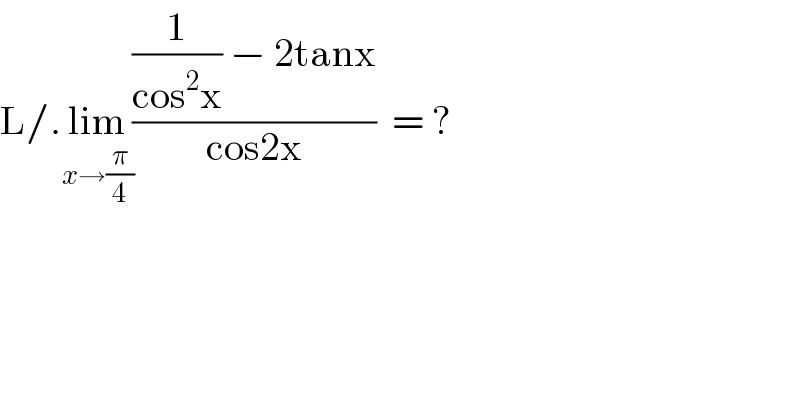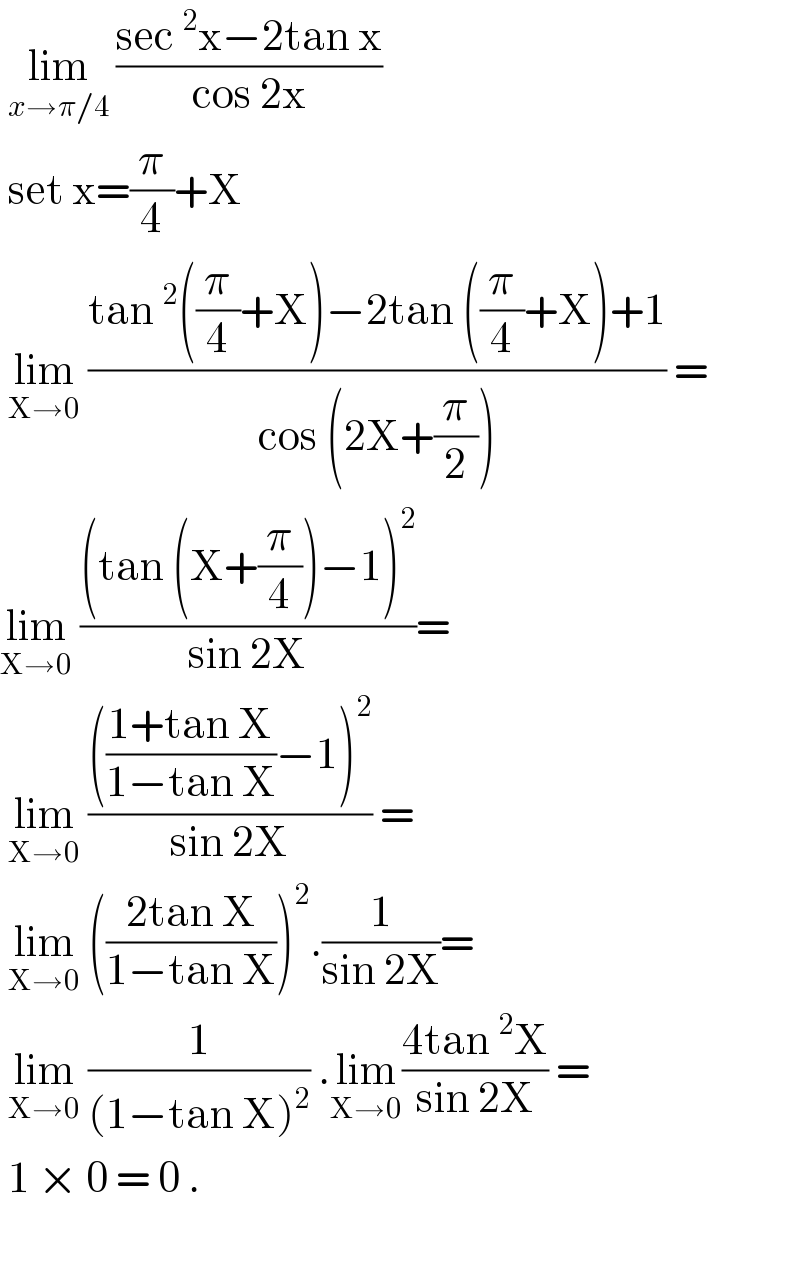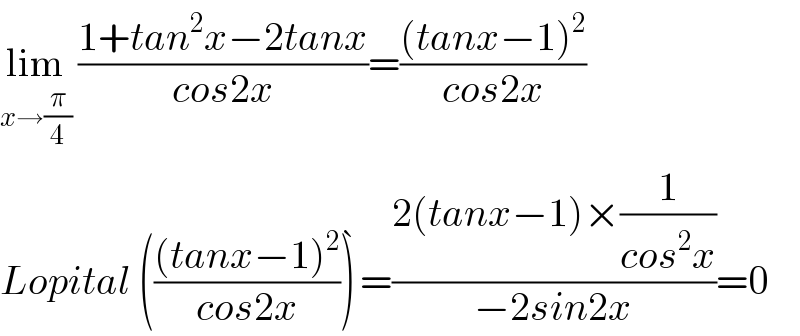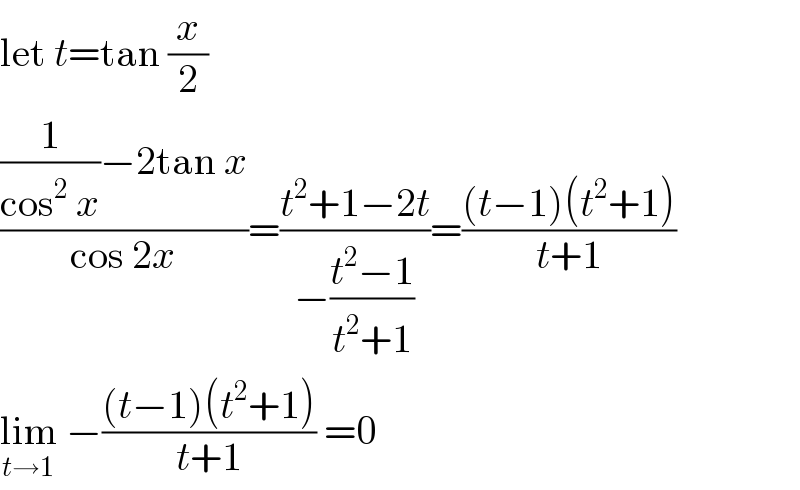Question Number 120914 by SOMEDAVONG last updated on 04/Nov/20

$$\mathrm{L}/.\underset{{x}\rightarrow\frac{\pi}{\mathrm{4}}} {\mathrm{lim}}\frac{\frac{\mathrm{1}}{\mathrm{cos}^{\mathrm{2}} \mathrm{x}}\:−\:\mathrm{2tanx}}{\mathrm{cos2x}}\:\:=\:? \\ $$
Answered by bemath last updated on 04/Nov/20

$$\:\underset{{x}\rightarrow\pi/\mathrm{4}} {\mathrm{lim}}\:\frac{\mathrm{sec}\:^{\mathrm{2}} \mathrm{x}−\mathrm{2tan}\:\mathrm{x}}{\mathrm{cos}\:\mathrm{2x}} \\ $$$$\:\mathrm{set}\:\mathrm{x}=\frac{\pi}{\mathrm{4}}+\mathrm{X} \\ $$$$\:\underset{\mathrm{X}\rightarrow\mathrm{0}} {\mathrm{lim}}\:\frac{\mathrm{tan}\:^{\mathrm{2}} \left(\frac{\pi}{\mathrm{4}}+\mathrm{X}\right)−\mathrm{2tan}\:\left(\frac{\pi}{\mathrm{4}}+\mathrm{X}\right)+\mathrm{1}}{\mathrm{cos}\:\left(\mathrm{2X}+\frac{\pi}{\mathrm{2}}\right)}\:= \\ $$$$\underset{\mathrm{X}\rightarrow\mathrm{0}} {\mathrm{lim}}\:\frac{\left(\mathrm{tan}\:\left(\mathrm{X}+\frac{\pi}{\mathrm{4}}\right)−\mathrm{1}\right)^{\mathrm{2}} }{\mathrm{sin}\:\mathrm{2X}}= \\ $$$$\:\underset{\mathrm{X}\rightarrow\mathrm{0}} {\mathrm{lim}}\:\frac{\left(\frac{\mathrm{1}+\mathrm{tan}\:\mathrm{X}}{\mathrm{1}−\mathrm{tan}\:\mathrm{X}}−\mathrm{1}\right)^{\mathrm{2}} }{\mathrm{sin}\:\mathrm{2X}}\:= \\ $$$$\:\underset{\mathrm{X}\rightarrow\mathrm{0}} {\mathrm{lim}}\:\left(\frac{\mathrm{2tan}\:\mathrm{X}}{\mathrm{1}−\mathrm{tan}\:\mathrm{X}}\right)^{\mathrm{2}} .\frac{\mathrm{1}}{\mathrm{sin}\:\mathrm{2X}}= \\ $$$$\:\underset{\mathrm{X}\rightarrow\mathrm{0}} {\mathrm{lim}}\:\frac{\mathrm{1}}{\left(\mathrm{1}−\mathrm{tan}\:\mathrm{X}\right)^{\mathrm{2}} }\:.\underset{\mathrm{X}\rightarrow\mathrm{0}} {\mathrm{lim}}\frac{\mathrm{4tan}\:^{\mathrm{2}} \mathrm{X}}{\mathrm{sin}\:\mathrm{2X}}\:= \\ $$$$\:\mathrm{1}\:×\:\mathrm{0}\:=\:\mathrm{0}\:.\: \\ $$$$ \\ $$
Answered by Jamshidbek2311 last updated on 04/Nov/20

$$\underset{{x}\rightarrow\frac{\pi}{\mathrm{4}}} {\mathrm{lim}}\:\frac{\mathrm{1}+{tan}^{\mathrm{2}} {x}−\mathrm{2}{tanx}}{{cos}\mathrm{2}{x}}=\frac{\left({tanx}−\mathrm{1}\right)^{\mathrm{2}} }{{cos}\mathrm{2}{x}} \\ $$$${Lopital}\:\left(\frac{\left({tanx}−\mathrm{1}\right)^{\mathrm{2}} }{{cos}\mathrm{2}{x}}\grave {\right)}=\frac{\mathrm{2}\left({tanx}−\mathrm{1}\right)×\frac{\mathrm{1}}{{cos}^{\mathrm{2}} {x}}}{−\mathrm{2}{sin}\mathrm{2}{x}}=\mathrm{0} \\ $$
Answered by MJS_new last updated on 04/Nov/20

$$\mathrm{let}\:{t}=\mathrm{tan}\:\frac{{x}}{\mathrm{2}} \\ $$$$\frac{\frac{\mathrm{1}}{\mathrm{cos}^{\mathrm{2}} \:{x}}−\mathrm{2tan}\:{x}}{\mathrm{cos}\:\mathrm{2}{x}}=\frac{{t}^{\mathrm{2}} +\mathrm{1}−\mathrm{2}{t}}{−\frac{{t}^{\mathrm{2}} −\mathrm{1}}{{t}^{\mathrm{2}} +\mathrm{1}}}=\frac{\left({t}−\mathrm{1}\right)\left({t}^{\mathrm{2}} +\mathrm{1}\right)}{{t}+\mathrm{1}} \\ $$$$\underset{{t}\rightarrow\mathrm{1}} {\mathrm{lim}}\:−\frac{\left({t}−\mathrm{1}\right)\left({t}^{\mathrm{2}} +\mathrm{1}\right)}{{t}+\mathrm{1}}\:=\mathrm{0} \\ $$
